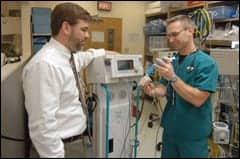 |
| Assistant director David Hambel, RRT-NPS (left), and Gary Lee, RRT, review the calibration of a nitric oxide delivery system. |
At the rate Good Samaritan Hospital Medical Center has been winning Quality Respiratory Care Recognition (QRCR) Awards, it may not be long before the West Islip, NY, facility needs a new wing just to house the trove of plaques commemorating the multiple times it was feted. A stretch, of course, but it is a fact that Good Samaritan to date has garnered three such laurels from the American Association for Respiratory Care. Good Samaritan’s first win occurred in 2004, one year after the QRCR Award debuted to honor facilities employing top-qualified respiratory therapists.
“The QRCR Award is evidence that a hospital is striving to ensure patient safety through adherence to strict criteria governing the delivery of respiratory care, including having bedside services provided by CRTs and RRTs on all shifts daily,” says Joseph Hock, RRT-NPS, CPFT, director of respiratory care at Good Samaritan.
Worth The Climb
Hock is firm in his belief that the respiratory care offered by Good Samaritan stands a cut above that available at other hospitals on Long Island. He attributes this in part to the talents of his energetic and compassionate staff of approximately 50 respiratory therapists. “We have a team here that is exceptionally strong in terms of expertise,” he says. “For example, most of our therapists have received ACLS-PALS [advanced cardiac life support-pediatric advanced life support] and neonatal resuscitation training, while a good many are accredited neonatal pediatric specialists.”
To promote development of staff expertise, the respiratory department some time ago began a clinical ladder. “Many of the requirements for climbing this ladder pertain to the acquisition of extra credentials,” Hock explains. “That proved to be a crucial motivator for our therapists to advance their knowledge—very important because, with 85,000 patient visits a year, we have the busiest emergency department on Long Island. We’re also a level II trauma center, with a level III neonatal intensive care unit.”
The 431-bed Good Samaritan Hospital Medical Center provides comprehensive oncology, cardiology, pediatric, and surgical care services, all of it complemented by an array of state-of-the-art diagnostic imaging capabilities. The hospital opened in 1959; 7 years later, the department of respiratory care was added. “Today, our respiratory therapists are deployed just about everywhere in the hospital,” says David Hambel, RRT-NPS, assistant director of respiratory care.
The Good Samaritan units currently generating the most caseload for therapists—and placing on them the greatest demand for superior skills—are the emergency department, the ICU, the CCU, and the NICU, according to Hock. “Volume in those units has been steadily rising,” he says. “We have a strong referral base, that’s one reason. Another is that we’ve had two hospital closures in the area, and we’re picking up a lot of their business.”
In recent years, respiratory services at Good Samaritan, which were previously confined to the inpatient hospital areas, have migrated to a number of outpatient centers. “A goal for us has been to bring as many of our services as possible to the outpatient side in support of the hospital’s efforts to build that part of its business,” says Hock.
Among the most important of those outpatient units is the cardiopulmonary rehabilitation center, which offers both a pulmonary program (started in 1985) and, as of January, a cardiac program. Approximately 3,500 pulmonary rehabilitation sessions are conducted there in the course of a typical year. “Ours is the second largest pulmonary rehab program in the state of New York,” says Jerome Weiner, MD, medical director of respiratory care.
Both programs provide exercise training for patients who seek to cope with respiratory or cardiac disabilities. “Each new patient referred to the cardiopulmonary rehabilitation center undergoes a thorough screening process to determine admission eligibility,” says Weiner. “Next, individualized goals of rehabilitation are established for each accepted patient, who, by the way, receives an extensive educational syllabus containing valuable learning materials having to do with his or her disease or condition. The patient undergoes therapy at the center for 8 to 12 weeks—three visits per week, 1 to 2 hours per visit. The sessions include use of supervised, cardiac-monitored exercise modalities.”
A team approach is taken at the center. Thus do respiratory therapists work alongside pulmonary medical specialists, registered physical therapists, registered dietitians, registered nurses, and consulting medical social workers, Hock reports.
More Points Of Care
Another outpatient unit where the contributions of respiratory therapists are deemed essential is the pulmonary function laboratory. Here, in addition to diagnosing adult asthma, emphysema, and other pulmonary problems, respiratory therapists play a leading part in testing children for signs of exercise-induced asthma.
Plans call for the launch of a second pulmonary function lab at the hospital’s new pediatric specialty center, slated to go live later this year. Hock says he intends to hire at least one more respiratory therapist and assign the newcomer to that unit.
Meanwhile, the hospital has organized a COPD support group that meets the first Thursday of each month to provide psychosocial support and education to patients and their families. Respiratory therapists oversee the group, which normally draws about 25 people per meeting. “We present a variety of different topics to educate those in attendance,” says Hock. “At the meeting held each May, we try to bring in an attorney as a guest speaker who talks about elder care and health care proxies. For our June gathering, we like to rent a boat and take the group out on the bay for an excursion that lasts a couple of hours. Two or three times a year, we take everybody out to lunch at local restaurants, and there’s always a big Christmas party for them—about 100 patients usually come out for that event.”
Increasingly important among the units where respiratory therapists work is the hospital’s six-bed adult sleep center for the diagnosis and treatment of obstructive sleep apnea and related breathing disorders. “The sleep lab coordinator is a respiratory therapist who is responsible for a staff of sleep technicians who perform polysomnography and CPAP titrations,” says Hock, who notes that the 10-year-old center is open 7 nights a week and, because it always operates at capacity, typically schedules patients 4 to 5 weeks in advance.
As well as operating the sleep center, the respiratory therapists provide education to patients before and after the studies. They also work with home care companies to see that patients receive CPAP therapy (which includes fitting masks, determining optimal pressure settings, and helping patients achieve compliance).
Lately, other sleep labs have opened in the area and that has somewhat cut into Good Samaritan’s share of the market. Hock is assured that his respiratory therapists will remain as busy as ever, however, once the ribbon is cut to inaugurate the hospital’s new four-bed pediatric sleep lab, part of the pediatric specialties center, located off campus.
Pushing For Improvements
New ways of providing care are continually explored by the respiratory department. For example, in October, it introduced a ventilator early-weaning protocol for adult ICU and CCU patients.
“It was not long after the protocol went into effect that average ventilator length-of-stays were shortened by 3 days—from 7 down to 4,” Hock discloses. “Our rapid-weaning protocol is based on recommendations of the Institute for Healthcare Improvement, stemming from its 100,000 Lives Campaign to prevent ventilator-associated pneumonia, among other life-endangering situations. In support of this protocol, we now have one therapist on the day shift who is dedicated to rapid weaning. She assesses all patients receiving mechanical ventilation for readiness to wean. In conjunction with the patients’ nurses, the determination is made whether they are candidates for rapid weaning. If the patients are assessed to be good candidates, they are placed on a ‘sedation vacation’ and a 5-minute spontaneous breathing trial is begun. If they pass the 5-minute trial based on medically approved criteria, they are progressed to a 30-minute spontaneous breathing trial. If the 30-minute trial is successful, the physicians are contacted for an order for extubation.”
Ventilator equipment to which this protocol applies at Good Samaritan are chiefly Puritan Bennett 840s and 7200s (other ventilators in use throughout the hospital include VIASYS VIPs for the NICU and the pediatric population, Sensormedics 3100A high-frequency oscillator, and Bird Avians for transport situations). On the subject of equipment, blood-gas analysis is conducted by means of a quartet of Siemens RapidLab 800s—one in the ER-trauma room, a second in the NICU delivery room, the next on the CCU floor, and the last in the respiratory care department’s office.
Inspired by the success of its ventilator early-weaning protocol, the department is poised to add nitric oxide therapy to its NICU treatment armamentarium. “This month [May] we will be ready to begin administering it,” says Hock. “We are very confident that nitric oxide therapy for newborns who have persistent pulmonary hypertension will be advantageous because it is so much less invasive and much more cost-effective than other options. Our projections anticipate us treating 20 to 30 cases a year.”
More Opportunities
It is because of these and other initiatives that the department places such a premium on respiratory therapist education. Fortunately, says Hambel, the department has long been cognizant of the benefits of having a highly knowledgeable and supremely trained staff. “We’re always encouraging those who have not yet gone out and become registered respiratory therapists to do so,” he says. “We try to promote education in ways that cause our people to stop and think and really appreciate how important it is for them. The message that education is vital is something we frequently present at staff meetings and even in passing in the corridors. Because people tend to grow comfortable where they are in their careers, we keep encouraging them not to because we don’t want to see them stagnate.”
Education is deemed so paramount at Good Samaritan that it long ago led the respiratory department to become a clinical training site for two local colleges. That turned out to be a smart move, because it makes recruitment easier in a market where good therapists are in short supply. “Many of the students who rotate through here apply for employment with us—they had a positive experience at Good Samaritan and want to build on that,” says Hock. “Usually, though, we try to get a jump on their job hunt by offering them employment before they finish their last clinical rotation with us.”
Looking around the hospital, there appear to be few places remaining where respiratory therapists—whether raw recruits or seasoned veterans—can yet be deployed. Nonetheless, when new business opportunities are proposed, it is the respiratory department that many almost reflexively turn to first for allied health support. “As new opportunities come up, we’ll be there to push forward and expand our role,” says Hock. “That’s how we see our mission. It’s all about being available to serve. That’s the good thing about our corporate culture here. In other facilities, attempts to spread respiratory therapists beyond their traditional roles are usually met with opposition from other specialties who perceive that as an intrusion on their turf. Not here. At Good Samaritan, we all see ourselves as part of one team, with one purpose, and that is to provide the best care possible for the patients who depend on us.”
Do not doubt that for so much as one moment. This is a department that has the awards to prove it.
Rich Smith is a contributing writer for RT. For further information, contact [email protected].








